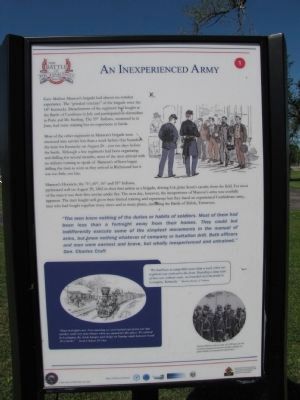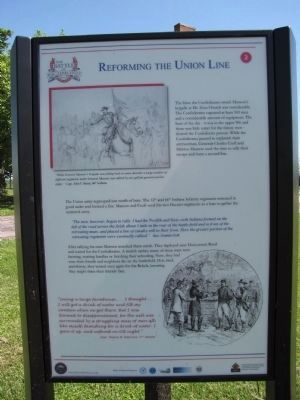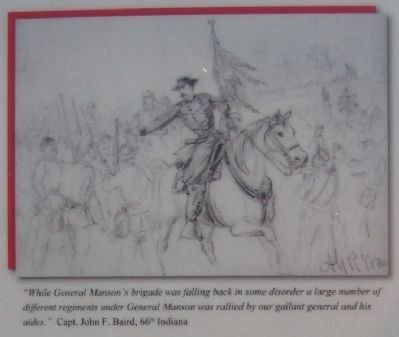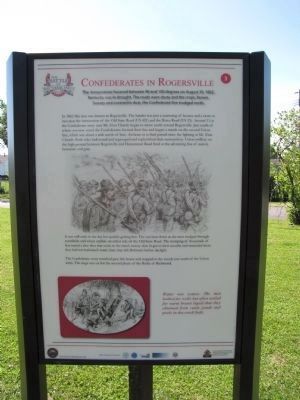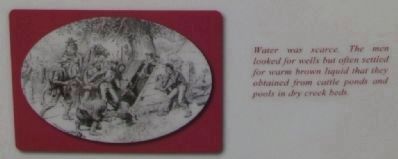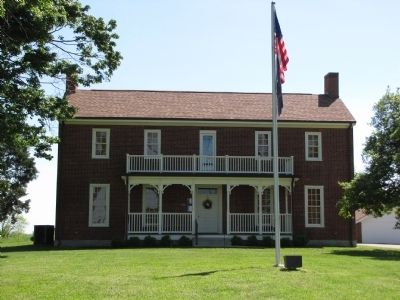Near Richmond in Madison County, Kentucky — The American South (East South Central)
Battle of Richmond
Kiosk 2
An Inexperienced Army
Gen. Mahlon Manson's brigade had almost no combat experience. The "grizzled veterans" of the brigade were the 18th Kentucky. Detachments of the regiment had fought at the Battle of Cynthiana in July and participated in skirmishes in Paris and Mt. Sterling. The 55th Indiana, mustered in in June, had some training but no experience in battle.
Most of the other regiments in Manson's brigade were mustered into service less than a week before they boarded the train for Kentucky on August 20 - just ten days before the battle. Although a few regiments had been organizing and drilling for several months, most of the men arrived with no military training to speak of. Manson's officers begain drilling the men as soon as they arrived in Richmond but was too little, too late.
Manson's Hoosiers, the 71st, 69th, 16th and 55th Indiana, performed well on August 29th, 1862 in their first action as a brigade, driving Col. John Scott's cavalry from the field. For most of the men it was their first service under fire. The next day, however, the inexperience of Manson's army was woefully apparent. The men fought well given their limited training and experience but they faced an experienced Confederate army, men who had fought together many times and in many places, including the Battle of Shiloh, Tennessee.
"The men knew nothing of the duties or habits of soldiers. Most of them had been less than a fortnight away from their homes. They could but indifferently execute some of the simplest movements in the manual of arms, but knew nothing whatever of company or battalion drill. Both officers and men were earnest and brave, but wholly inexperienced and untrained." Gen. Charles Cruft
"We had been in camp little more than a week when our regiment was ordered to the front. Boarding a long train of box cars without seats, we traveled via Cincinnati to Lexington, Kentucky." David LeSourd, 12th Indiana
"Slept in freight cars. Next morning we were turned ou of one car into another until very near dinner when we started for this place. We arrived in Lexington, Ky. tired, hungry and sleepy on Sunday night between 9 and 10 o'clock." David F. Rohrer, 95th Ohio
General Manson led an army of 6,500 men, for the most part inexperienced new recruits, against an equal number of seasoned Confederates.
(Side 2):
Reforming the Union Line
The blow the Confederates struck Manson's brigade at Mt. Zion Church was considerable. The Confederates captured at least 500 men and a considerable amount of equipment. The heat of the day - it was in the upper 90s and there was little water for the thirsty men - slowed the Confederate pursuit. While the Confederates paused to replenish their ammunition, Generals Charles Cruft and Mahlon Manson used the time to rally their troops and form a second line.
The Union army regrouped just north of here. The 12th and 66th Indiana Infantry regiments retreated in good order and formed a line. Manson and Cruft used the two Hoosier regiments as a base to gather the scattered army.
"The men, however, began to rally. I had the Twelfth and Sixty-sixth Indiana formed on the left of the road across the fields about 1 mile in the rear of the battle-field and in front of the retreating mass, and placed a line of cavalry still to their front. Here the greater portion of the retreating regiments were eventually rallied." Gen. Charles Cruft
After rallying his men Manson marched them north. They deployed near Duncannon Road and waited for the Confederates. A month earlier, many of these men were farming, starting families or finishing their schooling. Now, they had seen their friends and neighbors die on the battlefield. Hot, tired and thirsty, they waited once again for the Rebels, knowing they might share their friends' fate.
"Seeing a large farmhouse...I thought...I will get a drink of water and fill my canteen when we get there. But I was doomed to disappointment, for the well was surrounded by a struggling mass of
men all, like myself, famishing for a drink of water. I gave it up, and suffered on till night." Capt. Thomas M. Robertson, 71st Indiana
(Side 3):
Confederates in Rogersville
The temperature hovered between 96 and 100 degrees on August 30, 1862. Kentucky was in drought. The roads were dusty and the crops, brown. Sweaty and covered in dust, the Confederate line trudged north.
In 1862 this area was known as Rogersville. The hamlet was just a scattering of houses and a store or two near the intersection of the Old State Road (US 421) and the Berea Road (US 25). Around 11 AM the Confederate army near Mt. Zion Church began to move north toward Rogersville. Just south of where you now stand the Confederates formed their line and began a march on the second Union line, which as about a mile north of here. An hour or so had passed since the fighting at Mt. Zion Church. Both sides had rested and regrouped and replenished their ammunition. Union artillery on the high ground between Rogersville and Duncannon Road fired at the advancing line of men in butternut and gray.
It was still early in the day but quickly getting hot. The sun beat down as the men trudged through cornfields and wheat stubble on either side of the Old State Road. The tramping of thousands of feet raised a fine dust that stuck to the men's sweaty skin. It got in their mouths and reminded them they had not had much water since they left Bobtown before daylight.
The Confederate army marched past this house and stopped in the woods just south of the Union army. The stage was set for the second phase of the Battle of Richmond.
'Water was scarce. The men looked for wells but often settled for warm brown liquid they obtained from cattle ponds and pools in dry creek beds.'
Topics. This historical marker is listed in this topic list: War, US Civil. A significant historical year for this entry is 1862.
Location. 37° 41.058′ N, 84° 15.489′ W. Marker is near Richmond, Kentucky, in Madison County. Marker can be reached from the intersection of Battlefield Memorial Highway (U.S. 421) and Berea Road (U.S. 25), on the left when traveling south. Marker is on the grounds of the Battle of Richmond Visitor's Center. The kiosk's sides are numbered for stops 1, 2, and 3 of the tour of the battlefield. Touch for map. Marker is in this post office area: Richmond KY 40475, United States of America. Touch for directions.
Other nearby markers. At least 8 other markers are within walking distance of this marker. An Inexperienced Army (here, next to this marker); Confederates In Rogersville (here, next to this marker); Reforming The Union Line (here, next to this marker); Advance To Kingstown (a few steps from this marker); Engagement At Bobtown (a few steps from this marker); Encampment At Bobstown (a few steps from this marker); Patrick Ronayne Cleburne (within shouting distance of this marker); General Mahlon Manson (within shouting distance of this marker). Touch for a list and map of all markers in Richmond.
Credits. This page was last revised on November 3, 2020. It was originally submitted on June 1, 2010, by Lee Hattabaugh of Capshaw, Alabama. This page has been viewed 1,007 times since then and 13 times this year. Photos: 1, 2, 3, 4, 5, 6. submitted on June 1, 2010, by Lee Hattabaugh of Capshaw, Alabama. • Craig Swain was the editor who published this page.
